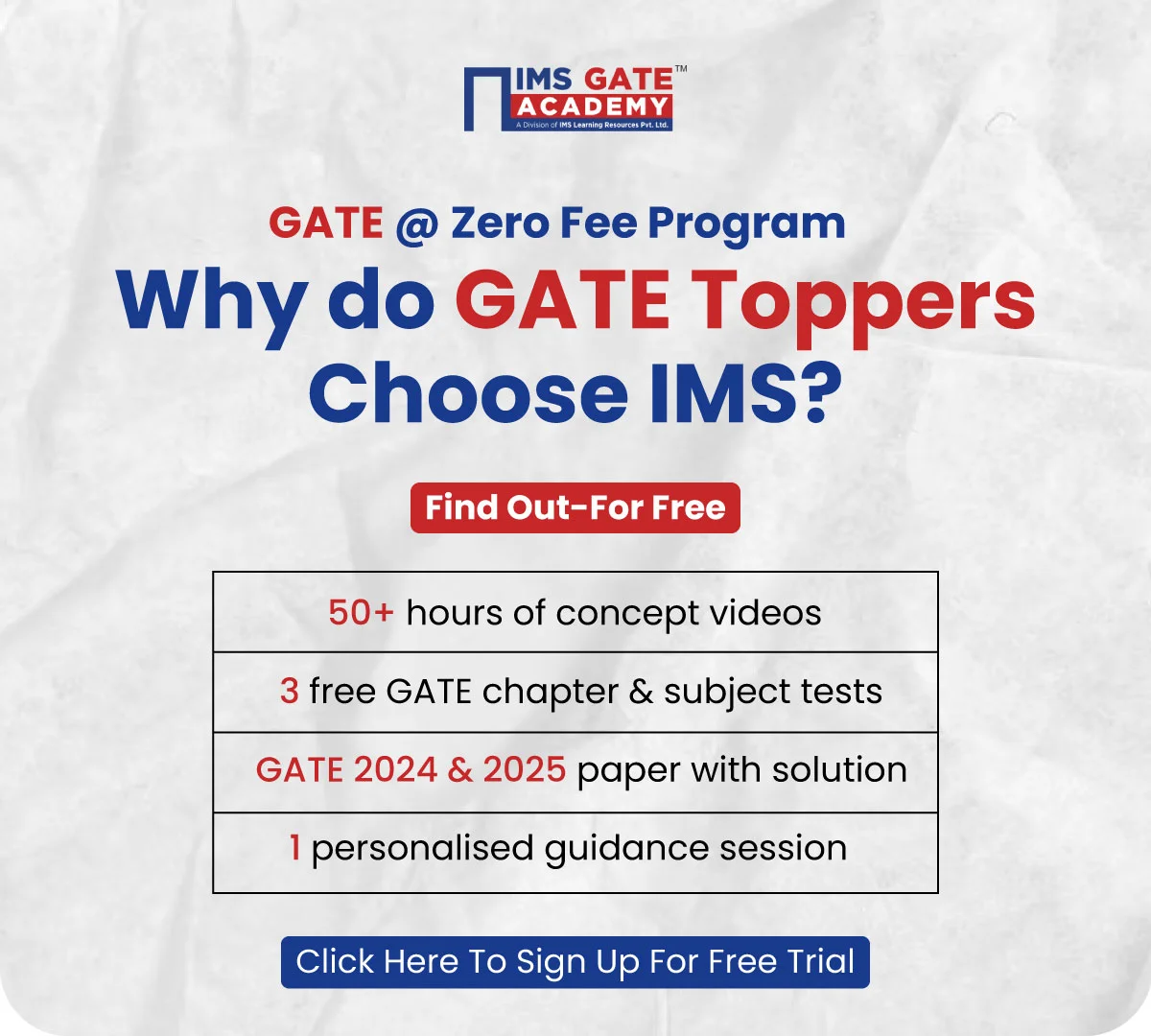GATE Syllabus for Aerospace Engineering (AE) 2026
The Graduate Aptitude Test in Engineering (GATE) 2026, conducted by IIT Guwahati, is a premier exam for aerospace engineering graduates aiming for M.Tech/Ph.D. programs at top institutes like IITs, NITs, and IISc, or careers in aerospace research and industry. The GATE Syllabus For Aerospace Engineering (AE) syllabus is structured into six sections, blending core and special topics to test technical and analytical skills.
Overview of GATE Syllabus For Aerospace Engineering 2026
The GATE 2026 AE syllabus covers six sections: Engineering Mathematics, Flight Mechanics, Space Dynamics, Aerodynamics, Structures, and Propulsion. Each section includes Core Topics (90% of questions) and Special Topics (10% of questions), as outlined in the GATE AE 2025 document, which is expected to be similar for 2026. The syllabus is designed for a 100-mark computer-based test (CBT) with MCQs, MSQs, and NATs, including a mandatory General Aptitude section (15 marks). The syllabus tests undergraduate-level knowledge, emphasizing aerospace-specific concepts.
Why Understand the Syllabus? A clear grasp of the GATE 2026 AE syllabus helps candidates prioritize high-weightage topics, streamline their study strategy, and excel in this competitive exam.
Read more: GATE Exam 2026: Eligibility, Registration, Important Dates, Syllabus, Paper Pattern, and Benefits
Detailed Breakdown of GATE Syllabus For Aerospace Engineering 2026
Below is a section-wise analysis of the GATE 2026 AE syllabus, detailing core and special topics, their significance, and weightage.
1. Engineering Mathematics (12–15 marks)
Engineering Mathematics is a foundational section, contributing 12–15 marks and providing analytical tools for aerospace engineering.
Core Topics:
- Linear Algebra: Vector algebra, matrix algebra, systems of linear equations, rank, eigenvalues, eigenvectors.
- Calculus: Functions of a single variable, limits, continuity, differentiability, mean value theorem, chain rule, partial derivatives, maxima/minima, gradient, divergence, curl, directional derivatives, line/surface/volume integrals, Stokes, Gauss, Green theorems.
- Differential Equations: First-order linear/non-linear ODEs, higher-order linear ODEs with constant coefficients, partial differential equations, separation of variables.
Special Topics:
- Fourier series, Laplace transforms.
- Numerical methods for linear/non-linear algebraic equations, numerical integration/differentiation.
- Complex analysis, probability, and statistics.
Significance: Essential for solving aerospace problems, such as trajectory calculations and structural analysis.
Weightage Table
| Topic | Approx. Marks | Priority |
| Calculus | 4–5 | High |
| Linear Algebra | 3–4 | High |
| Differential Equations | 3–4 | Medium |
| Special Topics | 1–2 | Low |
Read More: GATE Exam Preparation – What Is The Best Time To Start Preparing For GATE Exam?
2. Flight Mechanics (15–18 marks)
Flight Mechanics focuses on aircraft performance, stability, and control, a core area for aerospace engineering.
Core Topics:
- Basics: Atmospheric properties, standard atmosphere, aircraft classification, airplane configuration, parts, pressure altitude, airspeeds (equivalent, calibrated, indicated), primary flight instruments (altimeter, ASI, VSI, turn-bank indicator), angle of attack, sideslip, roll/pitch/yaw controls, aerodynamic forces/moments.
- Airplane Performance: Drag polar, take-off/landing, steady climb/descent, absolute/service ceiling, range/endurance, load factor, turning flight, V-n diagram, head/tail/cross winds.
- Static Stability: Stability/control derivatives, longitudinal stick fixed/free stability, horizontal tail position/size, directional stability, vertical tail position/size, lateral stability, wing dihedral/sweep/position, hinge moments, stick forces.
Special Topics:
- Dynamic Stability: Euler angles, equations of motion, decoupling of longitudinal/lateral-directional dynamics, longitudinal/lateral-directional modes.
Significance: Critical for understanding aircraft behavior and design.
Weightage Table
| Topic | Approx. Marks | Priority |
| Airplane Performance | 6–8 | High |
| Static Stability | 5–6 | High |
| Basics | 3–4 | Medium |
| Dynamic Stability | 1–2 | Low |
3. Space Dynamics (8–10 marks)
Space Dynamics covers orbital mechanics, a key area for space missions.
Core Topics:
- Central force motion, trajectory determination, and orbital period in simple cases.
- Kepler’s laws, escape velocity.
Special Topics:
- None.
Significance: Fundamental for satellite and spacecraft trajectory design.
Weightage Table
| Topic | Approx. Marks | Priority |
| Central Force Motion | 6–8 | High |
| Kepler’s Laws | 2–3 | Medium |
4. Aerodynamics (15–18 marks)
Aerodynamics examines fluid flow and aerodynamic forces, crucial for aircraft and spacecraft design.
Core Topics:
- Basic Fluid Mechanics: Conservation laws (mass, momentum, energy), dimensional analysis, dynamic similarity, potential flow theory (sources, sinks, doublets, line vortex, superposition), elementary viscous flows, boundary layers.
- Airfoils and Wings: Airfoil nomenclature, aerodynamic coefficients (lift, drag, moment), Kutta-Joukowski theorem, thin airfoil theory, Kutta condition, starting vortex, finite wing theory, induced drag, Prandtl lifting line theory, critical/drag divergence Mach number.
- Compressible Flows: Compressibility concepts, one-dimensional compressible flows, isentropic flows, Fanno/Rayleigh flows, normal/oblique shocks, Prandtl-Meyer flow, flow through nozzles/diffusers.
Special Topics:
- Wind tunnel testing: measurement/visualization techniques.
- Shock-boundary layer interaction.
Significance: Central to aerodynamic performance and vehicle design.
Weightage Table
| Topic | Approx. Marks | Priority |
| Airfoils and Wings | 6–8 | High |
| Compressible Flows | 5–6 | High |
| Basic Fluid Mechanics | 3–4 | Medium |
| Special Topics | 1–2 | Low |
Read More: GATE Syllabus For Civil Engineering (CE) 2026
5. Structures (15–18 marks)
Structures focus on material strength and structural dynamics, which are vital for aerospace vehicle integrity.
Core Topics:
- Strength of Materials: Stress/strain transformations, Mohr’s circle, principal stresses, 3D Hooke’s law, plane stress/strain, failure theories (maximum stress, Tresca, von Mises), strain energy, Castigliano’s principles, statically determinate/indeterminate trusses/beams, elastic flexural buckling of columns.
- Flight Vehicle Structures: Aircraft structure/material characteristics, torsion, bending, shear in thin-walled sections, loads on aircraft.
- Structural Dynamics: Free/forced vibrations of undamped/damped SDOF systems, free vibrations of undamped 2-DOF systems.
Special Topics:
- Vibration of beams.
- Theory of elasticity: equilibrium/compatibility equations, Airy’s stress function.
Significance: Ensures structural reliability under aerospace loads.
Weightage Table
| Topic | Approx. Marks | Priority |
| Strength of Materials | 6–8 | High |
| Flight Vehicle Structures | 5–6 | High |
| Structural Dynamics | 3–4 | Medium |
| Special Topics | 1–2 | Low |
6. Propulsion (12–15 marks)
Propulsion covers engines and rocket systems, which are key to aerospace vehicle performance.
Core Topics:
- Basics: Thermodynamics, boundary layers, heat transfer, combustion, thermochemistry.
- Aerothermodynamics of Aircraft Engines: Thrust, efficiency, range, Brayton cycle.
- Engine Performance: Ramjet, turbojet, turbofan, turboprop, turboshaft, afterburners.
- Turbomachinery: Axial compressors (angular momentum, work, compression, stage performance, efficiency, multi-staging), centrifugal compressors (stage dynamics, inducer, impeller, diffuser), axial turbines (stage performance).
- Rockets: Thrust equation, specific impulse, rocket performance, multi-staging, chemical rockets, solid/liquid propellant performance.
Special Topics:
- Aerothermodynamics of non-rotating components (intakes, combustor, nozzle).
- Turbine blade cooling, compressor-turbine matching, surge, stall.
Significance: Drives vehicle propulsion and efficiency.
Weightage Table
| Topic | Approx. Marks | Priority |
| Engine Performance | 4–5 | High |
| Turbomachinery | 3–4 | High |
| Rockets | 3–4 | Medium |
| Basics | 1–2 | Low |
| Special Topics | 1–2 | Low |
GATE 2026 AE Syllabus Weightage Summary
| Section | Approx. Marks |
| Engineering Mathematics | 12–15 |
| Flight Mechanics | 15–18 |
| Space Dynamics | 8–10 |
| Aerodynamics | 15–18 |
| Structures | 15–18 |
| Propulsion | 12–15 |
| General Aptitude (Common) | 15 |
Why does the GATE Syllabus for Aerospace Engineering Matter?
The GATE 2026 AE syllabus is meticulously designed to evaluate proficiency in aerospace engineering, covering mathematics, mechanics, dynamics, aerodynamics, structures, and propulsion. High-weightage sections like Flight Mechanics, Aerodynamics, and Structures (15–18 marks each) demand significant focus due to their complexity and direct application in aircraft and spacecraft design. Space Dynamics, with a lower weightage (8–10 marks), is crucial for space-related aspirations, while Engineering Mathematics and Propulsion provide foundational and technical depth.
The syllabus aligns with industry needs, preparing qualifiers for roles in aerospace design, propulsion engineering, and research. Topics like compressible flows, structural dynamics, and rocket performance are directly applicable to real-world challenges in aviation, defense, and space exploration.
Core vs. Special Topics: Core Topics (90% of questions) form the bulk of the exam, making them the primary focus. Special Topics (10%) require selective study, as they contribute fewer marks but can differentiate top performers.
Accessing the GATE 2026 AE Syllabus
The official GATE 2026 AE syllabus will be available on iitg.ac.in in August 2025. Candidates should download the PDF and compare it with the 2025 syllabus to anticipate minor updates, such as advancements in propulsion technologies or numerical methods. The syllabus is expected to remain largely consistent, ensuring continuity in preparation.
GATE Syllabus For Aerospace Engineering (AE): FAQs
- What is the weightage of Flight Mechanics in GATE 2026 AE?
Approximately 15–18 marks, one of the highest-weighted sections. - How are Core and Special Topics distributed in GATE 2026 AE?
Core Topics account for 90% of questions, and Special Topics account for 10%. - Where can I find the GATE 2026 AE syllabus?
Download it from iitg.ac.in once released (expected August 2025).
Read More:
| M.Tech Admission at DIAT Pune: Eligibility & Admission Process |
Conclusion
The GATE 2026 Aerospace Engineering syllabus is a robust framework covering Engineering Mathematics, Flight Mechanics, Space Dynamics, Aerodynamics, Structures, and Propulsion, alongside General Aptitude. With high-weightage sections like Flight Mechanics, Aerodynamics, and Structures, candidates must prioritize Core Topics (90% of questions) while selectively studying Special Topics (10%). Understanding the GATE 2026 AE syllabus is crucial for targeted preparation, unlocking opportunities for M.Tech/Ph.D. programs or careers in aerospace engineering at IITs, NITs, or leading organizations like ISRO and DRDO.








